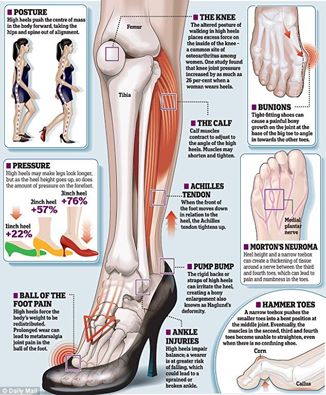Thongs or high hill shoes are damaging to the feet structure

Twenty-five percent of your bones are located in your feet and ankles, and your feet are the foundation of your body, carrying all your weight. With 26 bones and 33 joints in each foot, there’s plenty of opportunity for something to go wrong, especially if you choose ill-fitting or inappropriate footwear.
Certain footwear, including thongs and tight-fitting or high-heeled shoes, may damage your foot structure and change the dynamics of how you walk.
For instance, high heels (generally described as a heel height of 2 inches or higher) shift your foot forward into an unnatural position with increased weight on your toes.
Your body tilts forward, so you lean backwards and overarch your back to compensate. This posture changes the normal human gait and adds tremendous strain to your hips, lower back and your knees.
When worn long-term (defined as at least 40 hours a week for a minimum of two years), high heels lead to “substantial increases in muscle fascicle strains and muscle activation during the stance phase compared with barefoot walking.” Wearing high heels also places the calf muscle–tendon unit in a shortened position.
Even though thong-like sandals provide some cushioning benefit over bare feet alone, studies show they’re responsible for throwing human gait kinetics out of whack. The body is forced to compensate, and what starts as stress on the arch, heel, and the rest of the foot can eventually manifest as soreness in the legs, hips, and lower back.
Surprising as it may sound, some research suggests that even modern running shoes, with their heavily cushioned, elevated heels, may cause problems by encouraging runners to strike the ground with their heel first — a move that generates a greater collision force with the ground, leading to an increased potential for injury.
Forefoot- and mid-foot-strike gaits were probably more common when humans ran barefoot or in minimal shoes and may protect your feet and lower limbs from some of the impact-related injuries now experienced by a high percentage of runners.
Sources:
- Shroyer, JF; Weimar, WH (2010). "Comparative analysis of human gait while wearing thong-style flip-flops versus sneakers". Journal of the American Podiatric Medical Association 100 (4): 251–7. PMID 20660875.
- Shroyer, Justin F.; Robinson, Leah E.; Weimar, Wendi (August 27, 2009). Influence of thong flip‐flops on running kinematics in preschoolers (PDF). Annual Meeting of the American Society of Biomechanics. Penn State University.
- Shroyer, Justin (September 9, 2009). Influence of Various Thong Style Flip-flops on Gait Kinematics and Lower Leg Electromyography (PhD Thesis). Auburn, Alabama: Auburn University. pp. 31–52. hdl:10415/1905
- Narici, Marco; et al. (2010). "On muscle, tendon and high heels". The Journal of Experimental Biology. doi:10.1242/jeb.044271. Archived from the original on 20 April 2016. Research by Marco Narici et al. determined that persistent usage of high-heeled shoes causes the calf muscle to shorten – an average of 13% in their study – while the Achilles tendon becomes significantly thicker and stiffer. See The Economist, 17 July 2010, p. 84 for discussion.
- Barkema DD1, Derrick TR, Martin PE.Heel height affects lower extremity frontal plane joint moments during walking, Gait Posture. 2012 Mar;35(3):483-8. doi: 10.1016/j.gaitpost.2011.11.013. Epub 2011 Dec 12.
Site designed by Release-Remedial Therapies© | Login

We'd love to hear your reaction
Send Cancel